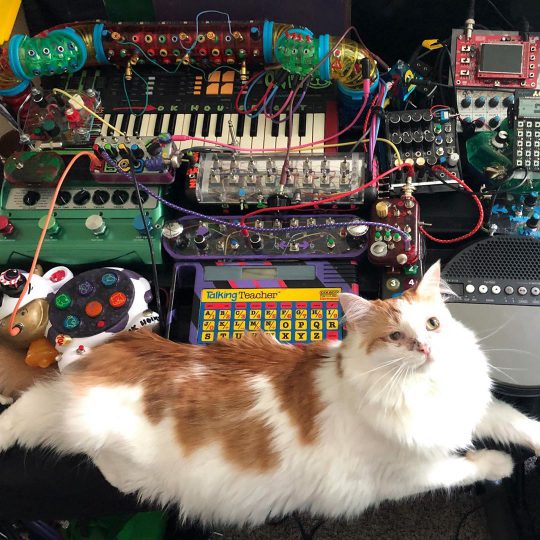
Charlotte returns with a sundry collection of circuit-bent creations by OK Housecat. Visit their Instagram or http://www.okhousecat.com/ for more images and info.


Charlotte returns with a sundry collection of circuit-bent creations by OK Housecat. Visit their Instagram or http://www.okhousecat.com/ for more images and info.
Today’s CatSynth video features our very own Big Merp. I was trying out an old photo theremin that I bought years ago, and decided to try playing it in front of Big Merp. Hilarity ensued. Definitely watch the video all the way to the end – the look on his face is priceless.
The photo theremin consists of a simple analog oscillator that uses a light-sensitive resistor (i.e.,a photocell) to control the frequency. So you can move your hand or other objects around it to change the light and thus change the pitch. This one also as an LFO for added sonic variety, and came in a really cool translucent blue case.
The West Village is an odd place. Streets cross one another at odd angles, leading to situations where numbered streets intersect, and small triangular slivers of park space emerge. One such location is the park where Christopher Street, Grove Street, West 4th, and 7th Avenue all meet.
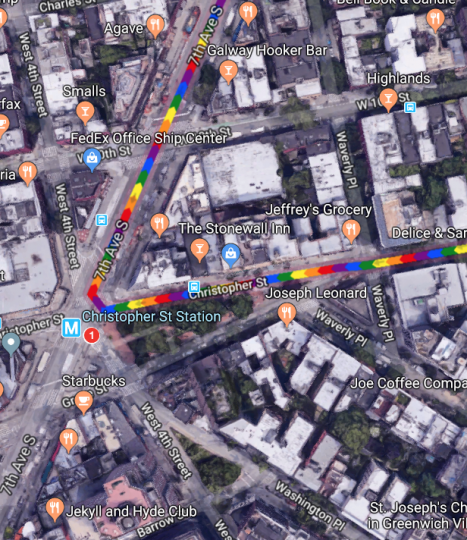
It’s a sliver of a park, but it includes the Christopher Street subway stop for the 1 IRT, a stop I have found most useful in recent years. And this angular collision of roads also has another significance.
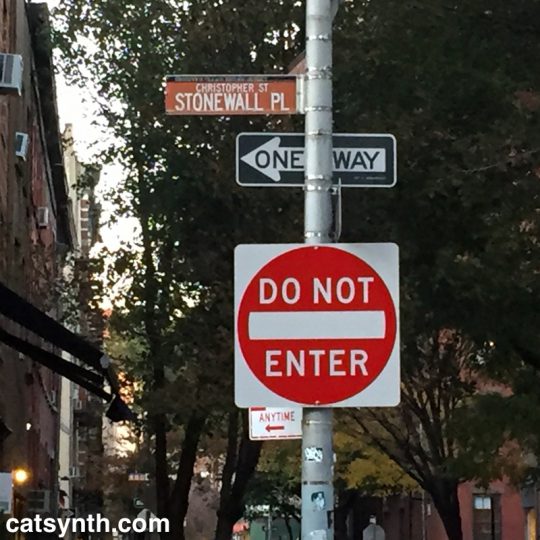
On the northern side of Christopher Street is the Stonewall Inn. The riots 50 years ago turned from a notorious Mafia-run bar for the most outcast members of the queer community to perhaps the sacred site in the world for the LGBTQ community and members of sexual minorities.
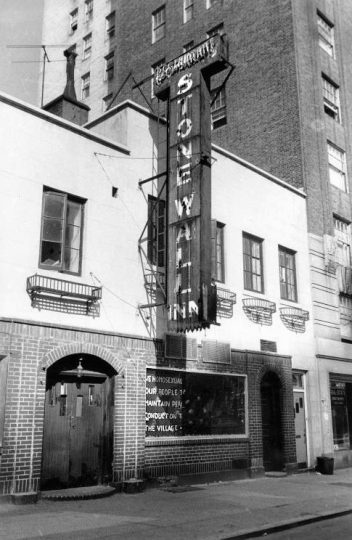
As people converge on lower Manhattan for New York Pride and World Pride – and we gather ourselves here in San Francisco, it’s worth looking back at what happened 50 years ago.
The age of the clientele ranged between the upper teens and early thirties, and the racial mix was evenly distributed among white, black, and Hispanic patrons.[57][59] Because of its even mix of people, its location, and the attraction of dancing, the Stonewall Inn was known by many as “the gay bar in the city”.[60] Police raids on gay bars were frequent—occurring on average once a month for each bar. Many bars kept extra liquor in a secret panel behind the bar, or in a car down the block, to facilitate resuming business as quickly as possible if alcohol was seized.[8][10] Bar management usually knew about raids beforehand due to police tip-offs, and raids occurred early enough in the evening that business could commence after the police had finished.[61] During a typical raid, the lights were turned on, and customers were lined up and their identification cards checked. Those without identification or dressed in full drag were arrested; others were allowed to leave. Some of the men, including those in drag, used their draft cards as identification. Women were required to wear three pieces of feminine clothing, and would be arrested if found not wearing them. Employees and management of the bars were also typically arrested.[61] The period immediately before June 28, 1969, was marked by frequent raids of local bars—including a raid at the Stonewall Inn on the Tuesday before the riots[62]—and the closing of the Checkerboard, the Tele-Star, and two other clubs in Greenwich Village.[63][64]
https://en.wikipedia.org/wiki/Stonewall_riots#Stonewall_Inn
What is notable is what the offenses were. The issues were not so much sexual practices as traditional gender norms. Women without at least three pieces of feminine clothing, men in drag were the targets. And khas vishalom they might even be dancing! It was all about control and conformity. I look back at it with a mixture of bewilderment, pity, disgust, and even contempt for people who were frightened and upset by these behaviors that they would criminalize it violently. And lest we get too smug, violence continues to this date in the United States, most notably the murders transgender women of color. And the attack on conformity is something to be celebrated rather than resisted – indeed that was part of what attracted to this world decades before I knew that I myself was a member of its motley lot.
Many are using the occasion of the 50th anniversary to remind everyone that Stonewall was a riot, a moment of fighting back, rather than simply a large parade. But the parades and celebrations are great, too, as a reminder of what has changed. Indeed, one of the most criticized elements of Pride in this decade of the 21st century is just how commercial and “corporate” it has become. Sure, it’s tacky at times and easy to be cynical about some corporations’ motives. But the point is that mainstream businesses want to be seen as being on the side of the LGBTQ community, the “right” side, and the “profitable” side. One day it will be those who were so frightened by and bothered by these expressions of love and individual identity that they must respond with violence and law who will be pushed to the margins. And push them we shall, but it a way that still preserves their dignity and individuality, lest we end up making similar mistakes.

Gracie is back, this time with a Korg Poly 61 synthesizer. From Alsún Ní Chasaide (Alison Cassidy) of Synthetic Dreamscapes, who repaired the instrument.
This unusual Korg Poly-61 with factory MIDI retrofit (not Poly-61m) is finally finished and working perfectly. As usual, the last 20% takes 50% of the time!
In this case, the non-working panel buttons were traced to severe oxidation around two connectors on the MIDI board. Both pin headers *and* connectors had to be completely replaced / rebuilt for this to be long-term reliable. Also, one new rubber key contact set was needed, and Andrej’s new CPU board from yesterday.
And after a tune-up – perfect!! Ready to go back to its local owner 👍🏼😊
Gracie is the Quality Engineer for these repair projects 😸🎹
I have attended the Garden of Memory at the Chapel of the Chimes in Oakland many a summer solstice since moving to San Francisco – and written multiple reviews on these pages and even presented a CatSynth TV showcase last hear. But 2019 is the first time I have performed at this annual event as a named artist. It’s a very different experience from the inside looking out. This article describes the adventure.

My friend and sometime collaborator Serena Toxicat and I were excited to be accepted into this years program for our project Manul Override. We joined forces once again with Melne Murphy on guitar and also invited Thea Farhadian to sit in with us on violin.
I had a rather elaborate setup, anchored as usual by my trusty Nord Stage EX. The Sequential Prophet 12 has also become a mainstay of my smaller collaborations, providing rich ambient sounds. The Arturia MiniBrute 2, Moog Theremini, and a collection of Eurorack modules rounded out the rig.
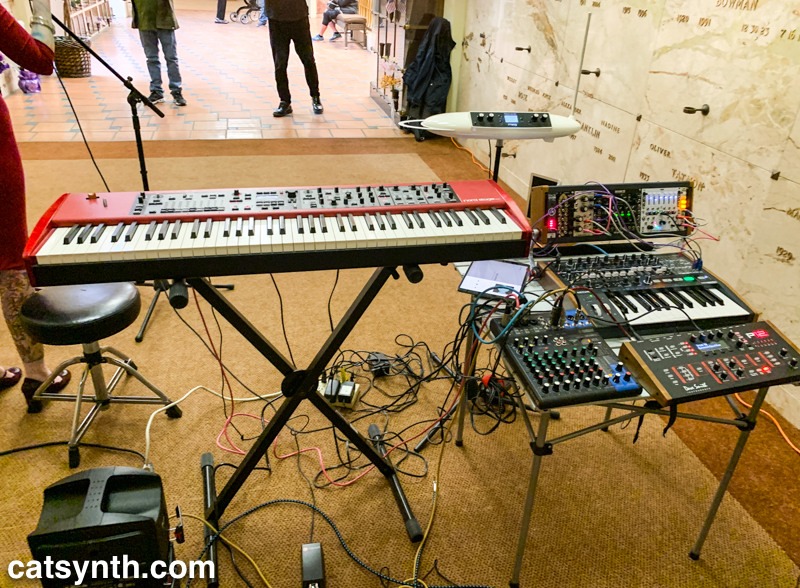
Getting everything into place in the catacombs-like building – a renowned landmark designed by Julia Morgan – was a challenge in itself. Fortunately, I found parking nearby and was able to load everything onto carts or wheeled cases, and had plenty of help getting things downstairs where we were playing.
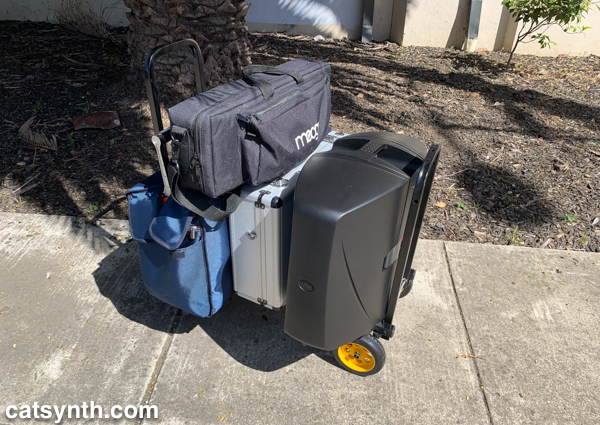
The acoustics of the space are also quite challenging. It is a set of oddly shaped stone chambers, some large, some small, so echoes abound from both the crowds and other performers. Figuring out how to balance our sound is not easy, and I don’t pretend to have gotten it right on the first try, but it’s a learning experience. But we did get ourselves sorted out and ready to play.
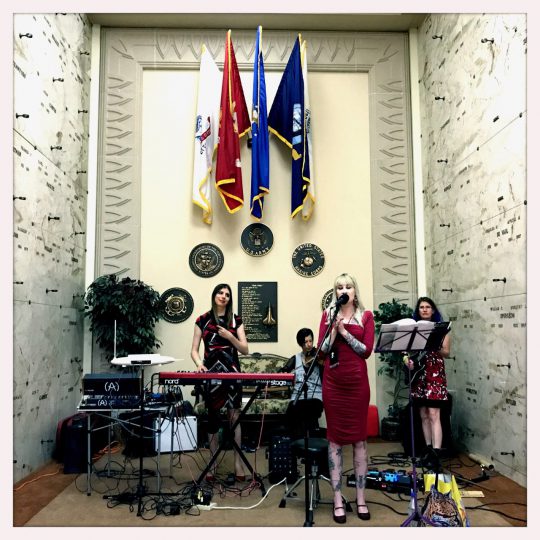
The set unfolded with an invocation, a drone in D mixolydian mode set to Serena’s text Mau Bast, read first in French and then in English. It seemed a perfect piece for the occasion. We then switched things up with a more humorous piece (Let’s Hear it for) Kitties, which was a crowd favorite. You can hear a bit of it in this video from the event.
I have learned how to best follow Serena’s style of speaking and singing, with a more open quality; and Melne and I know how to work together well both in terms of timing and timbre. Thea’s violin added an interesting counterpoint to the voice and electronics. Her sound was sometimes masked by the other instruments and the acoustics but when it came through it added a distinct character and texture. The remaining two pieces were more improvised. One was a free improvisation against one of Serena’s books Consciousness is a Catfish, and another was based on a graphical score with 16 symbols that I first created in 2010 but have revised and reused over the use. The newest version included a cartoon pigeon in honor of my bird-loving co-conspirator Melne.
The performance was well received. Crowds came and went throughout the evening, but many people stayed for extended periods of time to watch us, and others came back a few times. We played two hour-long sets, and in between I had a small amount of time to check out some of the other performs. In particular, I enjoyed hearing Kevin Robinson’s trio, with whom we shared our section of the space.
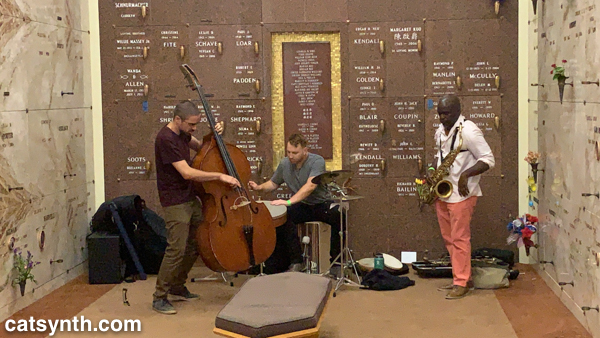
His spare group and arrangements with saxophone, upright bass, and drum, provided a distinct contrast to our thick sound. The moved between long drawn-out tones and fast runs with short notes that reverberated around the space in between. Robinson’s music often has a meditative quality, even when it is more energetic, so it fit well.
Around the corner from us was the Stanford Laptop Orchestra (SLOrk). They had a quiet set featuring performs seated on meditation cushions with laptops as well as various percussive objects as sound sources.

I was particularly inspired by Anne Hege and her Tape Machine, an instrument with a free-moving magnetic tape and several heads, pickups and tiny speakers. She sang into it at various points and moved the tape, created an instrumental piece that was part DIY-punk, part futuristic, and somehow quite traditional at the same time.
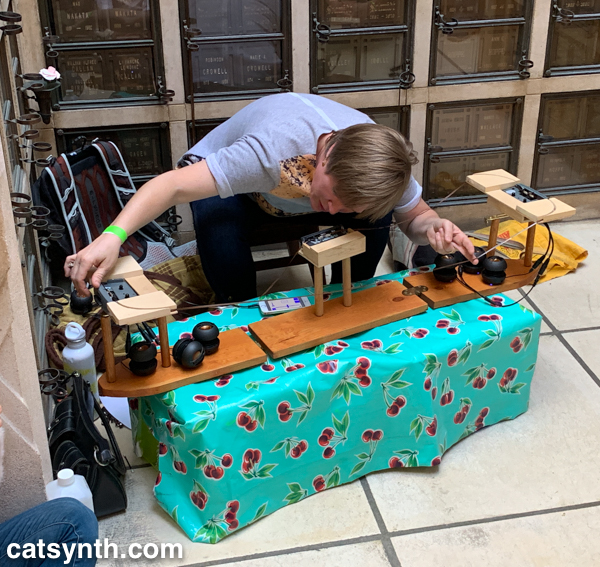
Her performance gave me ideas of a future installation, perhaps even to bring to the Garden of Memory in years to come…
Thea pulled double duty during the evening, also performing as part of a duo with Dean Santomieri, sharing a space with Pamela Z. Our friends Gino Robair and Tom Djll brought the duo Unpopular Electronics to one of the darker columbariums, and IMA (Nava Dunkelman and Amma Arteria) performed on the lower level. In retrospect, our group might have been better placed sharing a space with them, as we are both electronic groups (all women) with large dynamic range.
Overall, it was a wonderful experience, and with the opportunity to play as well as listen it’s my favorite to date. Thank you Sarah Cahill, Lucy Mattingly, and the rest of the crew at New Music Bay Area as well as the Chapel of the Chimes staff for letting us be a part of this event!
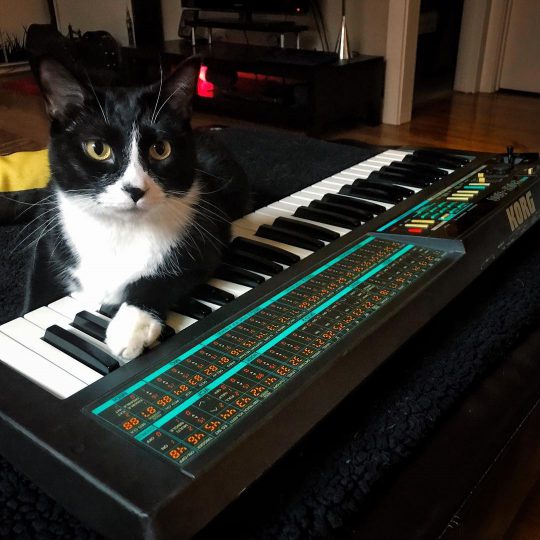
A cute tuxedo cat shows off a Korg Poly 800 synthesizer. From Cesar Inserny via Instagram.
True meownalog synthesizer.
The Korg Poly 800 was a popular affordable polyphonic-analog synthesizer. The first synthesizer that I considered was its successor, the Poly 800 mk2, though was steered away from it because of its lack of velocity sensitivity and small keyboard range. They can still be picked up rather affordably for those interested in trying this instrument out.